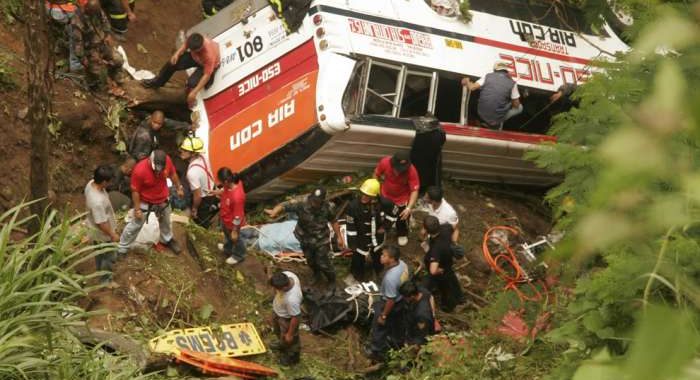Today marks the sixth year since two speeding buses rammed the taxi VERA Files’ Trustee Chit Estella-Simbulan was in while she was on her way to UP-Ayala Technohub in Quezon City for a reunion with high school classmates.
The road crash took her life.
This year is no different in her family’s search for justice. It is still characterized by postponement of hearings.
“Minsan yung lawyer is not available… lalo na doon sa kabila o kaya sa judge sometimes that has something urgent to do (Sometimes the lawyer is not available… mostly the defense side or sometimes the judge has something urgent to do),” said Roland Simbulan, husband of Estella-Simbulan.
Most recent among the many postponed hearings was the cross examination of the defense witness scheduled last February. Simbulan is yet to be advised when the next hearing is pushing through.
Over the last six years that friends and family of Estella-Simbulan have pursued their search for justice, the number of road crashes in the country has also continued to increase.
In Metro Manila alone, there were 77,946 road crashes in 2010, data from Metro Manila Recording and Analysis System (MMRAS) show.
The number jumped to 109,322 in 2016. These include 391 fatalities in 2010, a consistent upward trend from 2011 to 2015, with a slight decline to 429 in 2016.
Source: Metro Manila Accident Recording and Analysis System
The Philippine National Police (PNP), which records road crash data in the entire country, also shows an upward trend.
In 2013, PNP recorded 12,875 road crashes, which almost doubled to 24,565 in 2015.
The World Health Organisation (WHO) pegged the number who died in road crashes in the Philippines in 2013 at 10,379. This translated to a 2.6 percent loss in our gross domestic product (GDP) for that year.
The major culprit behind these figures: speeding. The same factor is attributed to the road crash that resulted in Estella-Simbulan’s death.
Speed is also the main focus in this year’s celebration of Road Safety Week. Themed “Slow down to save lives,” advocates gathered in a series of activities to discuss remedies including policies that would address the problem.
In a forum that details road safety initiatives of the Department of Transportation (DoTr) Tuesday, advocates called for an increased enforcement of speed limit in the Philippines.
At the same forum, DoTr’s Carlo Tabaloc presented the implementing rules and regulations (IRR) of Speed Limiter Act of 2016 (RA 10916), Children’s Safety on Motorcycle Act of 2015 (RA 10666), and the Anti-Distracted Driving Act of 2016 (RA 10913).
The IRR for Anti-Distracted Act and Children’s Safety on Motorcycles was signed on April 4.
Tabaloc said they’re targeting to have the IRR for Speed Limiter Act signed within the month.
It took almost a year before the IRR of the Road Safety Limiter Act was finalized since it lapsed into law in July 2016.
The law requires the mandatory installation of speed limiter in public utility and certain types of vehicles. It includes cargo trailers, trucks, buses, mini buses, delivery vans, shuttle services, tourist transport services, UVs, school services and cabs.
This measure is one of the good road safety laws that could have prevented the crash that killed Estella-Simbulan, a sentiment that her husband shared with VERA Files last year. (See Five years after, still no justice for Ma’am Chit)
Sophia San Luis, executive director of Imagine Law, is optimistic that once the IRR is signed the government will be able to implement the law within a year. Imagine Law is a nonprofit organization that utilizes its legal expertise to help curb road crashes in country.
San Luis however thinks the government should also focus on helping the Department of Trade and Industry (DTI) familiarize themselves on speed limiter devices.
“This is a very technical device, you have manual version and you have an electronic version,” said San Luis.
The DTI is the government agency in charge in setting the speed limiter standard. According to San Luis, the agency’s unfamiliarity of the speed limiter device contributed to the delay of the formulation of the standard.
While some advocates welcome these government initiatives, Simbulan is cautious. He calls for a stricter implementation of existing laws.
“Existing laws are not even enforced why bother about having new laws that will only add to the frustration?” he asked.
Simbulan added transportation government agencies only become stringent in implementing laws every time a road crash happen.
One of these laws that are not properly implemented is the Land Transportation and Traffic Code or RA 4136. The law sets the maximum allowable speeds for all roads within the Philippines and allows local government units to classify roads within its jurisdiction to determine the applicable speed limit.
Imagine Law, in a policy brief, observed applicable speed limits are not well publicized. Local governments also lack awareness of the need to classify roads or to set speed limits within their jurisdiction.
Based on their assessment, Imagine Law recommends local speed limit setting through local ordinance enactment, issuance of guidelines on local speed limit setting, and collection of speed limit ordinances and maintenance of centralized database of speed limits.
This story is produced under the Bloomberg Initiative Global Road Safety Media Fellowship implemented by the World Health Organization, the Department of Transportation and VERA Files.





